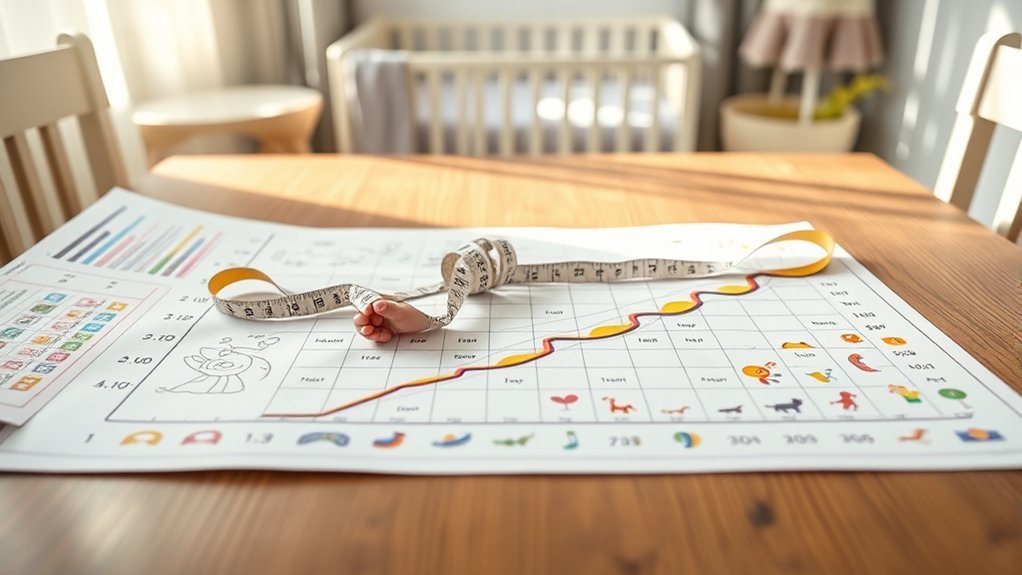Understanding growth charts is essential for monitoring your child’s development. These tools allow you to visualize their height, weight, and BMI against established percentiles. By grasping the key components and how to interpret the data, you can identify important trends in your child’s growth. This knowledge empowers you to support their health effectively. But what should you do if you notice significant changes? Let’s explore how to navigate these charts together.
Understanding the Basics of Growth Charts
Growth charts are essential tools that help track a child’s development over time. They provide a visual representation of height, weight, and body mass index (BMI) as your child grows. By comparing these measurements to standardized percentiles, you can assess whether your child is growing at an expected rate.
Typically, these charts are divided by age and sex, as growth patterns differ between boys and girls. Understanding growth charts enables you to identify potential health issues early on, allowing for timely interventions if necessary. Regularly updating these measurements guarantees you have an accurate view of your child’s growth trajectory.
Familiarity with growth charts empowers you to engage more effectively in discussions with healthcare providers about your child’s health and development.
Key Components of a Growth Chart
A growth chart consists of several key components that provide a detailed view of a child’s growth patterns. These elements help you track development over time and make informed decisions about health.
| Component | Description | Importance |
|---|---|---|
| Percentiles | Display how a child’s measurements compare to peers | Indicates growth trends |
| Age & Gender | Specify the child’s age and gender for accurate assessments | Tailors growth expectations |
| Measurement Units | Include height, weight, and head circumference | Provides extensive data |
Understanding these components allows you to interpret growth data effectively, ensuring you’re aware of any potential concerns. Regularly reviewing growth charts can facilitate timely interventions and promote ideal health outcomes for your child.
How to Read Growth Percentiles
Percentiles are a fundamental aspect of understanding a child’s growth chart, offering insights into how their measurements compare to those of their peers.
When you look at a growth chart, you’re often presented with various percentiles, typically ranging from the 3rd to the 97th percentile. If your child is at the 50th percentile for height, it means they’re taller than 50% of children their age and shorter than the other 50%.
Percentiles help you identify where your child stands in relation to others. A consistent percentile over time indicates steady growth, while significant shifts may warrant further evaluation.
Interpreting Growth Patterns and Trends
How can you effectively assess your child’s growth patterns and trends?
Begin by regularly plotting their height, weight, and head circumference on a growth chart. Look for consistent growth along a specific percentile line, which indicates stable development.
Note any significant fluctuations, as they may signal underlying health issues. Pay attention to growth spurts, which often occur during infancy and adolescence, but verify these align with expected developmental milestones.
It’s crucial to evaluate genetic factors, as they can influence growth patterns.
Finally, compare your child’s measurements to age-appropriate norms to understand their growth trajectory.
When to Consult a Healthcare Professional
When concerns about your child’s growth arise, it’s important to consult a healthcare professional. Early intervention can help identify underlying issues and guarantee your child’s development stays on track. Consider seeking advice if you notice any of the following signs:
| Concern | Action |
|---|---|
| Stagnant growth for over 6 months | Schedule an evaluation |
| Significant weight loss | Contact your pediatrician |
| Slow growth after age 2 | Discuss with a healthcare provider |
| Height or weight below the 5th percentile | Seek immediate consultation |
Frequently Asked Questions
What Factors Can Affect a Child’s Growth Rate?
Several factors can affect a child’s growth rate, including genetics, nutrition, hormonal levels, chronic illnesses, and environmental influences. Monitoring these elements helps guarantee your child’s development stays on track for ideal health and well-being.
How Often Should Growth Charts Be Updated?
You should update growth charts regularly, ideally during each health visit. This guarantees accurate tracking of growth patterns and helps identify any potential issues early, enabling timely interventions when necessary for your child’s development.
Are Growth Charts the Same for All Ages?
No, growth charts aren’t the same for all ages. They’re tailored to specific age groups, reflecting developmental differences. You need to use the appropriate chart for accurate assessments of growth and health for each child.
Can Growth Charts Predict Future Height?
While growth charts can provide insights into potential future height, they’re not definitive predictors. Genetics, nutrition, and health also play essential roles. So, consider growth charts as a useful tool, not a crystal ball.
What Should I Do if My Child Falls off the Growth Chart?
If your child falls off the growth chart, consult a pediatrician promptly. They’ll assess potential underlying issues, recommend dietary adjustments, and monitor growth patterns to guarantee your child’s health and development remain on track.
Conclusion
By regularly monitoring your child’s growth on these charts, you can gain valuable insights into their development and well-being. Understanding their growth patterns allows you to identify potential concerns early on. Remember, every child grows at their own pace, but are you doing enough to support their health journey? If you notice significant changes or have concerns, don’t hesitate to consult a healthcare professional for guidance. Your proactive approach can make all the difference in their development.
